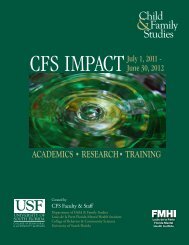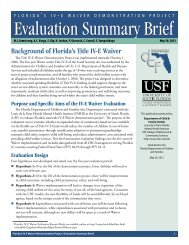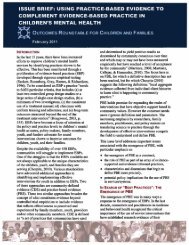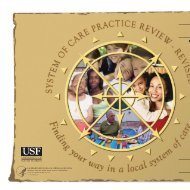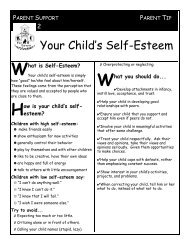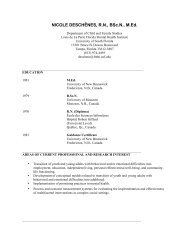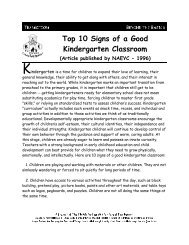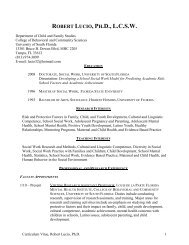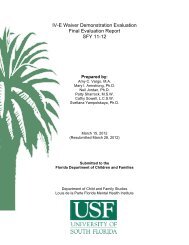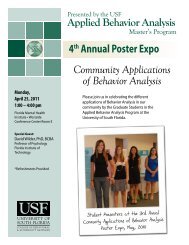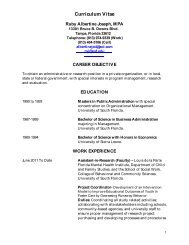The Early Learning Opportunities (ELO) Act - Child & Family Studies
The Early Learning Opportunities (ELO) Act - Child & Family Studies
The Early Learning Opportunities (ELO) Act - Child & Family Studies
Create successful ePaper yourself
Turn your PDF publications into a flip-book with our unique Google optimized e-Paper software.
Evaluation of the <strong>Early</strong> <strong>Learning</strong> <strong>Opportunities</strong> <strong>Act</strong><br />
Table 6<br />
Description of Students Participating in the Behavioral Component<br />
Gender<br />
Age<br />
(in mos.)<br />
Duration of Participation # of Sessions Status of Participation<br />
M 24 8/04 to 10/04 6 Completed Program<br />
M 47 1/05 to present In process Currently in Program<br />
M 58 5/04 to 8/04 10 Completed Program<br />
M 31 6/04 to 8/04 10 Completed Program<br />
F 40 8/04 to 9/04 5 Completed Program<br />
M 45 6/04 to 9/04 11 Completed Program<br />
M 40 8/04 to 10/04 2 Failure to Show<br />
F 36 8/04 to 10/04 4 Discontinued due to parent schedule<br />
Measures and Data Collection<br />
Teachers<br />
Knowledge Survey. One avenue for evaluating the impact that participation in the <strong>ELO</strong><br />
project had on early childhood educators was to examine their levels of knowledge both before<br />
and after completion of the HUR course. To accomplish this task, a pre and posttest <strong>Early</strong><br />
Literacy Instruction Knowledge survey was administered to all teachers. Specifically, this survey<br />
was comprised of nine multiple choice and six true and false items that asked respondents to<br />
define literacy terms as well as research-based applications of these strategies into early<br />
childhood settings. <strong>The</strong> knowledge survey was administered at the first and last HUR classes to<br />
all participating teachers. All items were weighted equally; thus, a total of 19 points were<br />
possible.<br />
Beliefs About Implementing Literacy Skill Scale (BAILSS). <strong>The</strong> BAILSS was developed to<br />
assess teachers’ attitudes towards the importance, competence, and use of literacy skills in<br />
their classrooms and family child care centers. <strong>The</strong> BAILSS is an 84-item self-rating scale for<br />
participants in the HUR course. Each item includes a literacy skill as the stem and a three point<br />
Likert scale rating for importance, competence, and use of each skill. See Appendix A for a copy<br />
of the instrument. <strong>The</strong> literacy skills were taken directly from the HUR curriculum’s weekly<br />
suggestions for implementing the lessons. <strong>The</strong> ratings for importance or feelings toward skill<br />
(affect), competence or feelings about ability to use skill (cognition), and use of skill (behavior)<br />
were derived from Katz’s (1960) three components of attitude (i.e. affect, cognition, and<br />
behavior) as attitude or behavioral intent can predict actual behavior.<br />
<strong>The</strong> BAILSS was administered to the summer cohort of teachers prior to the first lesson and<br />
after the last lesson of the HUR course. <strong>The</strong> pre- scores were compared to the post-scores and<br />
the coaching group’s scores were compared to the no coaching group’s scores. To score the<br />
BAILSS, each rating of “yes” or “often” was worth two points; “somewhat” or “sometimes” was<br />
worth one point; and “no” or “not yet” was worth zero points. A composite score for each<br />
respondent was derived as well as a subscale score for importance, competence, and use.<br />
Cronbach’s alpha was conducted on time one data to determine the internal consistency of<br />
each scale. <strong>The</strong> Cronbach’s alpha for the composite scale was .948, for Importance was .805,<br />
for Competence was .944, and for Use was .909. <strong>The</strong>se reliability indices are based on the<br />
deletion of two items from the Importance (i.e. 9a,18a) and two items from the Use scale (i.e.<br />
Louis de la Parte Florida Mental Health Institute, University of South Florida – page 8



